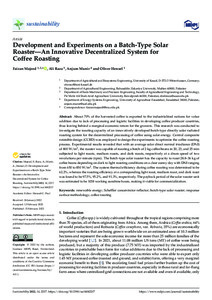| dc.date.accessioned | 2022-04-26T14:32:30Z | |
| dc.date.available | 2022-04-26T14:32:30Z | |
| dc.date.issued | 2022-02-15 | |
| dc.identifier | doi:10.17170/kobra-202204216066 | |
| dc.identifier.uri | http://hdl.handle.net/123456789/13791 | |
| dc.description.sponsorship | Gefördert durch den Publikationsfonds der Universität Kassel | ger |
| dc.language.iso | eng | eng |
| dc.rights | Namensnennung 4.0 International | * |
| dc.rights.uri | http://creativecommons.org/licenses/by/4.0/ | * |
| dc.subject | renewable energy | eng |
| dc.subject | Scheffler concentrator reflector | eng |
| dc.subject | batch-type solar roaster | eng |
| dc.subject | response surface methodology | eng |
| dc.subject | coffee roasting | eng |
| dc.subject.ddc | 600 | |
| dc.subject.ddc | 630 | |
| dc.title | Development and Experiments on a Batch-Type Solar Roaster—An Innovative Decentralized System for Coffee Roasting | eng |
| dc.type | Aufsatz | |
| dcterms.abstract | About 70% of the harvested coffee is exported to the industrialized nations for value addition due to lack of processing and logistic facilities in developing coffee producer countries, thus leaving behind a marginal economic return for the growers. This research was conducted to investigate the roasting capacity of an innovatively developed batch-type directly solar radiated roasting system for the decentralized processing of coffee using solar energy. Central composite rotatable design (CCRD) was employed to design the experiments to optimize the coffee roasting process. Experimental results revealed that with an average solar direct normal irradiance (DNI) of 800 W/m2, the roaster was capable of roasting a batch of 2 kg coffee beans in 20, 23, and 25 min subjected to light roasts, medium roasts, and dark roasts, respectively at a drum speed of two revolutions per minute (rpm). The batch-type solar roaster has the capacity to roast 28.8–36 kg of coffee beans depending on dark to light roasting conditions on a clear sunny day with DNI ranging from 650 to 850 W/m2. The system thermal efficiency during coffee roasting was determined to be 62.2%, whereas the roasting efficiency at a corresponding light roast, medium roast, and dark roast was found to be 97.5%, 95.2%, and 91.3%, respectively. The payback period of the solar roaster unit was estimated to be 1038 working sunshine hours, making it viable for commercialization. | eng |
| dcterms.accessRights | open access | |
| dcterms.creator | Majeed, Faizan | |
| dcterms.creator | Raza, Ali | |
| dcterms.creator | Munir, Anjum | |
| dcterms.creator | Hensel, Oliver | |
| dc.relation.doi | doi:10.3390/su14042217 | |
| dc.subject.swd | Erneuerbare Energien | ger |
| dc.subject.swd | Konzentrator <Solartechnik> | ger |
| dc.subject.swd | Reflektor <Lichttechnik> | ger |
| dc.subject.swd | Kaffeeverarbeitung | ger |
| dc.type.version | publishedVersion | |
| dcterms.source.identifier | eissn:2071-1050 | |
| dcterms.source.issue | Issue 4 | |
| dcterms.source.journal | Sustainability | eng |
| dcterms.source.volume | Volume 14 | |
| kup.iskup | false | |
| dcterms.source.articlenumber | 2217 | |


